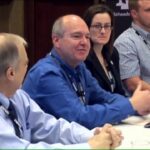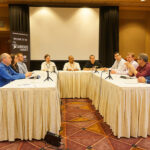|
|

Carlos Gomez and Chris Lyttle and Daniel Cybulskie and David Morton and Don Barry and Jennifer Huber and Partha Narasimhan and Randy Monroe and Ryan Holland and Sam Clements and Sean Rynearson presented for HPE Aruba Networking at RAA12 |

This video is part of the appearance, “Tech Field Day Roundtables at Aruba Airheads Conference 2012“. It was recorded as part of Tech Field Day Roundtable at Aruba Airheads 2012 at 14:00-16:00 on March 22, 2012.
Watch on YouTube
Watch on Vimeo
The Tech Field Day presentation on High-Density Wireless LAN, recorded on March 22, 2012, brought together a diverse panel of experts to discuss the challenges and solutions associated with deploying wireless networks in high-capacity venues. Sean Rynearson introduced the roundtable discussion, emphasizing the shift from designing for coverage to designing for high density. This shift is necessitated by the increasing number of devices each user carries, such as phones, tablets, and laptops, which can saturate older wireless cells. The panelists, including representatives from universities, large public venues, and Aruba Networks, shared their experiences and insights on managing high-density wireless environments, particularly in settings with high noise floors and rogue access points.
One of the key points discussed was the importance of minimizing the time each client spends on the air to maximize the efficiency of the wireless network. This involves keeping clients at high data rates and ensuring they quickly roam to access points with better connectivity. The analogy of buses on a road was used to illustrate this concept: smaller packets (or people) allow for more efficient use of the available bandwidth. The panelists also highlighted the need for proper infrastructure utilization, such as ensuring access points are correctly tuned and channels are appropriately managed, whether through static or dynamic channelization. Innovative design strategies, like placing access points under buildings to use the attenuation of concrete floors, were also mentioned as effective ways to reduce cell size and interference.
The discussion also touched on the challenges of dealing with legacy devices and the need for careful planning and validation in high-density deployments. The panelists noted that simply trimming data rates to increase airtime fairness can be complicated by the presence of older devices that still require connectivity. They emphasized the importance of spectrum analysis and adaptive radio management to ensure the airspace is usable and to mitigate the impact of rogue devices. The conversation underscored the necessity of a circular planning process, where continuous validation and adjustment are crucial. The panelists also shared experiences from unexpected high-density scenarios, such as gymnasiums and lecture halls, and discussed the ongoing issue of users bringing their own network devices, which can interfere with the venue’s wireless network.
Personnel: Carlos Gomez, Chris Lyttle, Daniel Cybulskie, David Morton, Don Barry, Jennifer Huber, Partha Narasimhan, Randy Monroe, Ryan Holland, Sam Clements, Sean Rynearson








